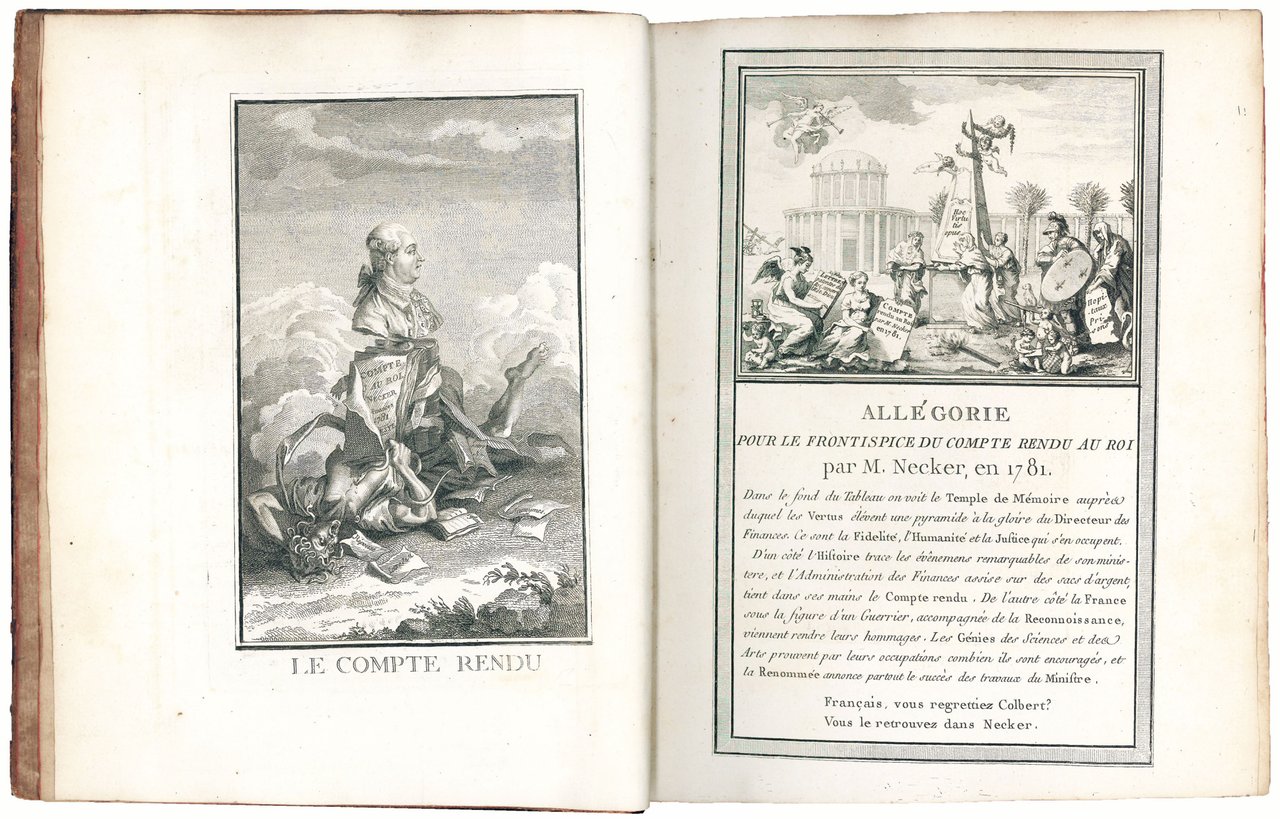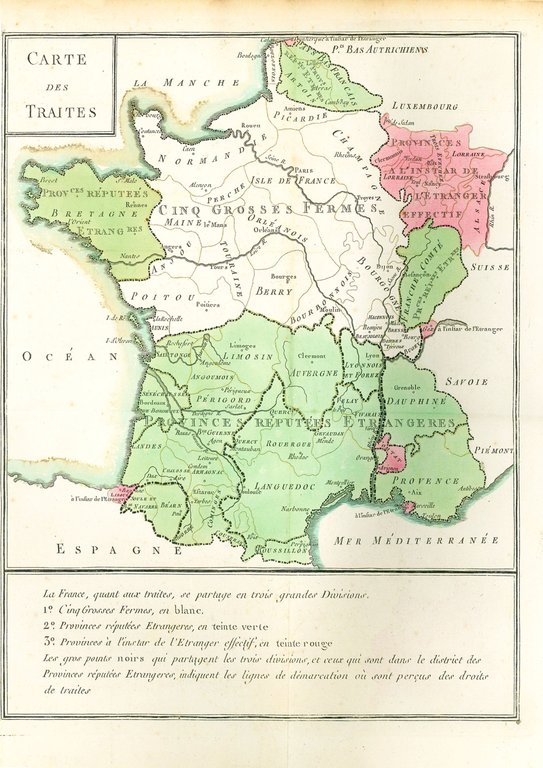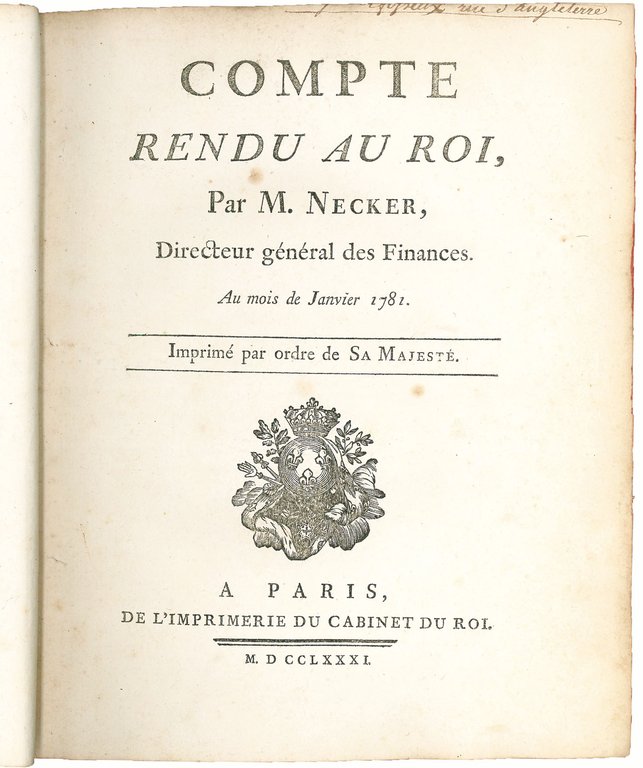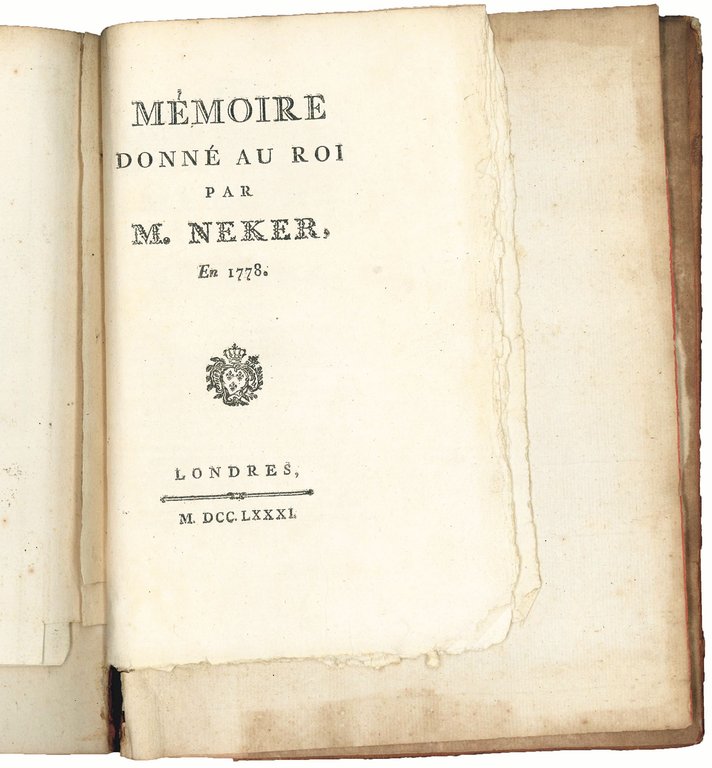




Livres anciens et modernes
NECKER, Jacques (1732-1804)
Compte rendu au Roi par M. Necker Directeur général des Finances Au mois de Janvier 1781. Imprimé par ordre de sa Majesté
de l''Imprimerie du Cabinet du Roi, 1781
2500,00 €
Govi Libreria Antiquaria
(Modena, Italie)
Les frais d'expédition corrects sont calculés une fois que l'adresse de livraison a été indiquée lors de la création de la commande. Un ou plusieurs modes de livraison sont disponibles à la discrétion du vendeur : standard, express, economy, in store pick-up.
Conditions d'expédition de la Librairie:
Pour les articles dont le prix est supérieur à 300 euros, il est possible de demander un plan de paiement échelonné à Maremagnum. Le paiement peut être effectué avec Carta del Docente, Carta della cultura giovani e del merito, Public Administration.
Les délais de livraison sont estimés en fonction du temps d'expédition de la librairie et de la livraison par le transporteur. En cas de retenue douanière, des retards de livraison peuvent survenir. Les frais de douane éventuels sont à la charge du destinataire.
Pour plus d'informationsMode de Paiement
- PayPal
- Carte bancaire
- Virement bancaire
-
-
Découvrez comment utiliser
votre Carta del Docente -
Découvrez comment utiliser
votre Carta della cultura giovani e del merito
Détails
Description
[Bound with:] EIUSDEM. Mémoire donné au Roi par M. Neker, En 1778. Londres, 1781.
Two works in one volume, 4to (244x194 mm) and 8vo (215x135 mm). Compte rendu: engraved frontispiece with Necker's bust, another engraved frontispiece (Allégorie pour le frontispice du Compte rendu au Roi par M. Necker, en 1781), [4], 116 pp., one folding letterpress table (Revenus and Dépenses) between pp. 114 and 115, and 2 hand-colored folding maps (Carte des Gabelles and Carte des Traités). Mémoire: 32 pp. Contemporary mottled calf, gilt spine, red edges (worn and rubbed, joints and spine partially repaired, traces of lettering piece on spine). On the front flyleaf, stamped in red, “ex libris, J.M. Defosseux 17[?]4”. On the title page trimmed manuscript note at the top. Compte rendu: light browning throughout, some occasional foxing and marginal staining. Mémoire: uncut with deckle edges.
First edition, first issue printed in January 1781 by the Imprimerie du Cabinet du Roi in a few copies which were not for sale. The nearly contemporary second issue was printed by the Imprimerie Royale. The present copy is exceptional in that it contains two engraved frontispieces, not present in most copies.
“Jacques Necker (1732-1804), was one of the most celebrated finance ministers of the Ancien Régime. He was appointed Directeur général by Louis XVI as the successor to Anne-Robert-Jacques Turgot. Necker was born in Geneva, the son of a Prussian professor of public law in Geneva. From 1747, he had studied banking in Paris at Isaac Vernets, where he became a partner by 1762 before co-founding the bank Thelusson, Necker et Ce. Encouraged by his wife, he became the Director of the French East India Company. In 1776, after the failure of Turgot's reforming attempts to liberalise the French economy, the young Louis XVI called upon Necker to succeed him. He was appointed Directeur géneral of the indebted finances of France in June 1777. Necker's first concern was to bring ordinary expenditure into balance with ordinary revenue. His reforms were known as ‘améliorations'; he cut expenses seemingly everywhere he could. While his policy to contain expenditure was consistent with that of his predecessors, he eliminated more venal offices, abolished numerous sinecures, divided the ‘taille' capitation tax more equally, abolished the ‘vingtième d'industrie', and reduced numerous treasurers and controllers for military and royal households. He also reformed the Ferme Générale, the oligarchy of the powerful ‘tax farmers' contracted by the government and put some of their activities under State supervision. His true skill, however, was the acquisition and juggling of credit. He borrowed millions through bankers in his native Geneva and signed off on a series of new and revised loans to help fund the French debt; he built up a staggering public debt and ruinous rates of interest to avoid raising taxes but created the illusion of a recovering economy. Not fully aware of the exposure of his national finances, Louis XVI committed his support to the American Revolution, first with material aid for the rebellious American colonists, then with a declaration of war against Great Britain in March 1778. Necker financed it almost entirely by borrowing, a fact that shocked his detractors, rendered the debt unsustainable by early 1781 and disappointed the king who blamed him. In February 1781, Necker controversially published the first Compte rendu au Roi, a statement of the king's finances, not a budget: ‘un compte public à lui rendre du succès de mes travaux, & de l'état actuel de ses Finances' (p. 1). In making the accounts public, Necker disclosed the secrets of the government to the public for the first time in history, eight years before the French Revolution. The report revealed at the same tim

